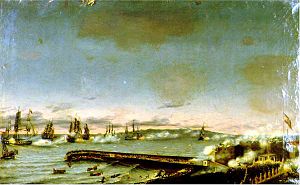Battle of Santa Cruz de Tenerife (1797)
| Battle of Santa Cruz de Tenerife | |||||||
|---|---|---|---|---|---|---|---|
| Part of the French Revolutionary Wars | |||||||
 The British attack on Santa Cruz de Tenerife. Oil on canvas, 1848. |
|||||||
|
|||||||
| Belligerents | |||||||
|
|
|
||||||
| Commanders and leaders | |||||||
|
|
|
||||||
| Strength | |||||||
| 4,000 regulars and sailors, 3 ships of line, 1 fourth rate, 3 frigates, 1 cutter, 1 bomb-vessel, 400 guns |
1,700 regulars, militia, and sailors, 91 guns |
||||||
| Casualties and losses | |||||||
| 250 dead, 128 wounded ~300 captured 1 cutter sunk |
30 dead, 40 wounded |
||||||
The Battle of Santa Cruz de Tenerife was an amphibious assault by the Royal Navy on the Spanish port city of Santa Cruz de Tenerife in the Canary Islands. Launched by Rear-Admiral Horatio Nelson on 22 July 1797, the assault was defeated, and on 25 July the remains of the landing party withdrew under a truce, having lost several hundred men. Nelson himself had been wounded in the arm, which was subsequently partially amputated: a stigma that he carried to his grave as a constant reminder of his failure.
In February 1797 the British defeated a Spanish fleet near Cape St. Vincent but failed to strike a solid blow against the Spanish Navy in the uneven struggle. Admiral John Jervis sailed for Lisbon after the engagement, frustrated at the escape of several valuable prizes including the Santísima Trinidad. New orders from the Admiralty demanded that he subdue and blockade the Spanish port of Cádiz, where much of the battered Spanish squadron had sought shelter. The First Sea Lord thought that the ease of Jervis' victory over José de Córdoba y Ramos guaranteed a successful attack on that southern harbour. Events proved otherwise.
Jervis' ships besieged Cádiz but were repelled by unexpected Spanish resistance. The Spaniards, under Vice-Admiral Mazarredo, organized a flotilla of small gunboats converted from yachts. With a clear advantage in the harbour's shallow waters, these vessels manoeuvred in the darkness and savaged Jervis' heavy ships of the line, striking at their vulnerable areas with impunity. Coastal batteries opened fire, joined by Spanish warships anchored at harbour, and drove the attackers back, causing the British to lose grip over the blockade and allowing several merchant convoys to slip in and out of the port.
...
Wikipedia
